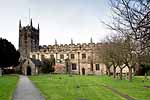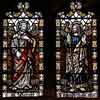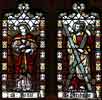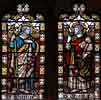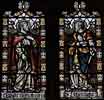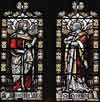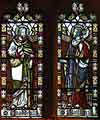For this church:    |
|
Key to Glass |
In the 1860s, St Giles’ still retained some fine examples of medieval stained glass. In 1863, Samuel Dutton Walker visited the church and wrote, 'Portions of this glass are of a splendid ruby far surpassing in depth of tone anything which we see in modern glass, and at the close of our visit a westering sun shed its glorious light through the windows of the church, giving quite a ‘Turneresque’ feeling and haze throughout the nave.' The following year he produced a pamphlet on the medieval glass in the church and wrote that 'we cannot boast of the possession of much original glass of this date and quality in the neighbourhood; indeed, we much doubt whether a parallel can be found in the whole county.'
As Phillimore recounted, the medieval glass was destroyed during the church restoration of 1871. However, there is a report that 'a few fragments of the old glass were embodied in the new stained glass window at the east end of the old south aisle'. This would be window 16 in the numbering shown here on the plan of the current church and used below.
Nave
1.Great West Window
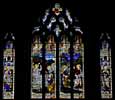 |
 Detail of tracery Detail of tracery |
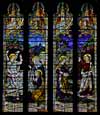 Detail Detail |
 Detail Detail |
A plaque on the south wall of the tower records that:

| THE WEST WINDOW WAS PRESENTED TO THE CHURCH BY FREDERICK JOHN TRUMAN (CHURCHWARDEN 1933-1937) TO THE GLORY OF GOD AND IN LOVING MEMORY OF HIS WIFE MELVINA 21ST JUNE 1936 |
Mr Truman was born in Lincoln, where he married Melvina Shelton in 1894. She was from Staffordshire but had been working as a housemaid for the vicar of St Peter with St Margaret in Lincoln. The couple came to live in Nottingham, where Mr Truman founded a decorating business in Palatine Street in about 1910, before settling in West Bridgford. Mr Truman was proud of his Lincolnshire roots, being for a time president of the Nottingham Lincolnshire Society. He was very active in bowls, connected with several clubs in the area, and served as president of the Notts. Bowling Association. At St Giles’ he was a member of the choir for over 30 years. Mrs Truman died in 1927 and Mr Truman in 1942 in his eightieth year.
The window is by Harry Grylls and, in the central four lights, portrays the Resurrection scene in the garden. On the leftmost pair, an angel is shown in front of the empty tomb above the inscription 'He is risen, He is not here'. On the rightmost pair the risen Christ is shown with Mary Magdalene above the words 'Touch me not for I am not yet ascended to my father'. Above all, is Christ crowned, surrounded by angels. One angel carries the words 'I am the resurrection and the life'. Elsewhere, from Psalm 68:18, is written 'Thou hast ascended on high' and 'Thou hast led captivity captive'.
A further light, on the left, shows Saint Peter. Above him are the words from 1 Peter 1:21, 'Who by him do believe in God, that raised him up from the dead and gave him glory'. On the far right is Saint Paul. Above him, from 1 Corinthians 15:20, reads 'Now is Christ risen from the dead and become the first fruits of them that slept'.
North Aisle
2.Window for the 1998 Centenary
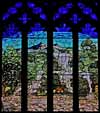 |
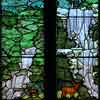 Detail Detail |
The text in the four-light window declares the window to have been 'given by the people of St Giles in 1998 to celebrate the centenary of the building of the central nave and chancel in 1898.' It was designed by local artist and member of St Giles’ congregation, Jennifer Bell, and executed with M E Stained Glass of Newark. Mrs Bell wrote about the window:
'The brief for the design of the 1998 window was to show St Giles’ and her three daughter churches (St Luke’s, St Paul’s, and All Hallows). The image of the waterfall seemed immediately right; God’s Spirit as the water, flowing from the Holy Mountain, forging its way through field and bedrock, overflowing from one church through another and on again, sweeping leaves (only decorative at the sides of the window – the design taken from a window in the Lady Chapel – but becoming real in the water) over the sill into the church. (The stars bursting into the sky are also taken from a motif in another window.)
'The picture as a whole is straight from the Psalms, and in fact if you look closely you will see verses written in the painting of the grass and trees. Among them are: As the deer pants for streams of water, so my soul pants for you, O God. My soul thirsts for God, for the living God. Psalm 42. The earth is the Lord’s and everything in it, the world and all who live in it. Psalm 24. The Lord is my shepherd, I shall not be in want. He makes me lie down in green pastures, he leads me beside quiet waters, he restores my soul. Palm 23. I lift my eyes to the hills – where does my help come from? My help comes from the Lord, the Maker of heaven and earth. Psalm 121. … Just as in the world outside you can see God’s word written right through creation … if you look.'
3.Laws Memorial Window
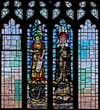 |
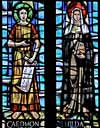 Detail Detail |
The main figures in this four-light window are Caedmon and St Hilda. Caedmon cared for animals at the monastery of Whitby Abbey when St Hilda was abbot. According to Bede, Caedmon learned to compose songs as a result of a vision. Beneath Caedmon is shown a harp; while below St Hilda is a representation of Whitby Abbey on its cliff.
Text at the base of window states:
| IN MEMORY OF A FAITHFUL CHORISTER FRED VICTOR LAW WHO DIED 23RD JUNE 1962. THIS WINDOW IS INSTALLED AT THE WISH OF HIS WIDOW HILDA. |
Mr Laws was a chorister at St Giles’ for 37 years. His wife, Hilda, who died in July 1968, served as a chorister at St Giles’ for 40 years.
The window was designed by Whitefriars Stained Glass Studios of Wealdstone, Middlesex and was erected in 1971/72.
4.Lawson Memorial Window
 |
 Detail Detail |
 Detail Detail |
The text in the two-light window declares that the window was
|
Peter Lawson served on the PCC of St Giles’ for around 40 years, including time as churchwarden. He was the driving force behind several building projects, including the new parish hall and the rectory. He became a Reader and took services not only at St Giles’ but also elsewhere in the Deanery. In the wider community, he served on Rushcliffe Borough Council and was Mayor of Rushcliffe in 1990/91. He was honoured by the PCC in 2007 when he was created Churchwarden Emeritus.
The window was installed in 2001. It was designed by local artist and member of St Giles’ congregation, Jennifer Bell, and executed with M E Stained Glass of Newark. Mrs Bell wrote about the window:
'The format for the 1998 window is echoed in the visual structure of the new window: strong colour at the top – deep blue and turquoise in the former, deep red, amber and yellow in the latter – the natural colours of both middle sections show landscape, trees, and the river flowing from the far distance, and at the bottom of both windows the water sweeps into the foreground.
'Peter Lawson wanted this new window to be in memory of his mother and sister, and approved a design based on the theme of restoration and new life for those who grieve, and the promise of eternal life for those who believe, using imagery mostly from Isaiah and the book of Revelation. Scriptures (taken from the New International Version of the Bible) are again written into the painting.
'In this window, the river is the River of the water of life, flowing from the Holy City, the new Jerusalem. It is a projection of holiness into the world, a provision of grace. There is a river whose streams make glad the city of God, the holy place where the Most High dwells. Psalm 46:4. As in the 1998 window, it winds through the landscape. Here, the Lamb, Christ, stands at the top of the waterfall, traces of his blood mixing with the water. Whoever drinks the water I give him will never thirst. Indeed, the water I give him will become in him a spring of water welling up to eternal life. John 4:13. the blood of Jesus … purifies us from all sin. 1 John 1:7. For the Lamb at the centre of the throne will be their shepherd; he will lead them to springs of living water and God will wipe away every tear from their eyes. Rev 7:17.
'The animals, (us), the powerful and the vulnerable, are standing in the water and drinking from it, washed with the blood of the lamb, and receiving the grace to live together. The wolf will live with the lamb, the leopard will lie down with the goat … for the earth will be full of the knowledge of the Lord Isaiah 11:6. They are entwined in the vine, again a symbol of Christ. I am the true vine … Remain in me, and I will remain in you. John 15:1,4. A root will come up from the stump of Jesse; from his roots a branch will bear fruit. The Spirit of the Lord will rest on him. Isaiah 11:1.
'Central to the window is Christ, the link between the Old Testament prophecy and hope, New Testament sacrifice and redemption, and Revelation’s ultimate homecoming. It is on Christ, wounded and bleeding into the water, that the Spirit of God rests. This is the one who came by water and blood – Jesus Christ. For there are three that testify – the Spirit, the water and the blood, and the three are in agreement. 1 John 6:6. The Spirit of the Lord is on me, because the Lord has anointed me to preach good news to the poor. He has sent me to bind up the broken-hearted … to comfort all who mourn, and provide for those who grieve … They will be called oaks of righteousness, a planting of the Lord for the display of his splendour. They will rebuild the ancient ruins and restore the places long devastated. Isaiah 71:1-4 The trees by the river are these oaks, given new life through the Spirit to restore their lives. Burst into songs of joy together, you ruins of Jerusalem, for the Lord has comforted his people. Isaiah 52:9
'The design of the trees frames the view of the Holy City, the focus for Christ, and, should we choose to follow him, then ours as well. Written (very subtly) on the wall of the city are the verses Now the dwelling of God is with men, and he will live with them. They will be his people and God himself will be with them and be their God. He will wipe away every tear from their eyes. There will be no more death or mourning, or crying or pain, for the old order of things has passed away Rev 2:1,3,4″
George Chapel
5.Thompson Memorial Window
 |
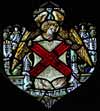 Detail Detail |
 Detail Detail |
 Detail Detail |
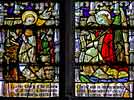 Detail Detail |
The window is in two main lights, depicting Melchisedek and Jesus, the good shepherd. In the Bible, Melchisedek was a priest and king, perhaps even superior to Abraham, and Jesus is identified as a high priest of the order of Melchisedek. Under the main figures is a representation of the Annunciation. By the Virgin Mary are the words 'Ave Maria gratia plena' (Hail Mary, full of grace.)
At the foot of the window is the dedication:
| To the Glory of the Risen Christ and in loving memory of Albert Thompson. Died November 9th 1913. This window is erected by his business associates. |
As Jesse Boot’s business started to grow, he took on Albert Thompson as his General Manager. Thompson went on to become Boot’s right-hand man, not only as a Director of the Boots company but also as the confidential servant of Sir Jesse and Lady Boot. On the day of Thompson’s funeral, 13th November, the whole of Boots’ warehouses and shops were closed from noon to 4 o’clock to enable the employees to be present. There was 'an impressive service in the West Bridgford Parish Church, the accommodation of which was taxed to the uttermost'. Following the service, the route from the church to the Rock Cemetery in Nottingham was, in many places, thickly lined with people. At the cemetery itself there was a crowd several thousands in number.
Thompson was a convinced Churchman and, for some time, was a member of the church council at St Giles’. Although he was a manager of the local schools, and was interested in local affairs, he took no active part in public life.
6.Gift of James Abbott Simons
 |
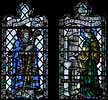 Detail Detail |
 Detail Detail |
 Detail Detail |
James Abbott Simons was a local builder and, as the dedication of this window declares, a long serving member of St Giles’ choir:
| THE GIFT OF JAMES ABBOTT SIMONS A MEMBER of the CHOIR of this CHURCH for SIXTY YEARS. 1886-1946 |
The window was by James Powell of London, and was dedicated on Sunday, 12 October 1947. At the top of the window is the shield of Southwell Cathedral, whilst in the very bottom left hand corner is a shield containing a deer and an arrow – a reference to St Giles. The remainder of the window depicts six figures with a musical theme, starting with the Te Deum.
Each of the six figures is accompanied by an appropriate text:
St Ambrose – 'We praise thee O God'
St Cecilia – 'All the Earth doth worship thee'
David – 'O come let us sing unto the Lord'
B.V. Mary – 'My soul doth magnify the Lord, Holy is His name'
Zacharias – 'Blessed be the Lord God'
Simeon – 'Now lettest thou thy servant depart in peace'
7.Second World War Memorial Window
 |
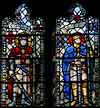 St George and St George andSt Martin |
 Sailor and soldier Sailor and soldier |
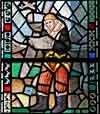 Pilot Pilot |
 Detail of inscription Detail of inscription |
A year after the end of the Second World War, the church council contemplated installing a stained glass window in memory of the fallen which would 'embody figures of soldier saints, and scenes from the sea and an airfield, to commemorate the Navy and the RAF'. The West Bridgford Branch of the British Legion took this on as a project towards the end of 1948 and, within a year, raised the £300 necessary.
The dedication took place on Sunday, 5th February 1950. It was to be unveiled by Major-General Sir John Whitaker, County President, and dedicated by the Chaplain-General, Rev F Ll Hughes. However, the Chaplain-General came down with influenza and the Archdeacon of Nottingham, the Venerable John Phillips, took his place. Otherwise, everything went according to plan and Sir John Whitaker remarked that he had never seen such a large congregation in a parish church before.
The glass was made by James Powell and Sons of London. The window was described in the parish magazine as 'in the modern style with bright colours, and clear glass which allows plenty of light even on dull days'. It has the Royal Arms at the top. Below are two military knights, St George and St Martin. The latter’s saint’s day is 11th November; he is always shown with a fine cloak, as a story is told of him that one cold day he cut it with his sword and gave half of it to a poor man in need by the wayside. Below the saints are four scenes, each with a man in uniform of the Services – Navy, Army, Air Force and Merchant Navy – with their badges and Divisional Signs in the border. Underneath, with the badge and poppy on either side, is written the Legion Act of Homage (with the first line slightly misquoted):
| They shall not grow old As we that are left grow old Age shall not weary them Nor the years condemn At the going down of the Sun And in the morning We will remember them A.D. 1939 – 1945 |
8.Craddock & Buckle Memorial Window
 |
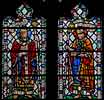 St Paulinus and St Paulinus andArchbishop Thomas |
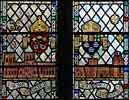 York Minster and York Minster andSouthwell Minster |
 West Bridgford church West Bridgford church before and after restoration |
The window celebrates the jubilee in 1958 of the extension of the church and shows St Giles’ as it was before and after 1898. West Bridgford was, until 1827, in the diocese of York, but looked to Southwell Minster as its 'mother church'. It was dedicated on 10 July 1960.
The window is in two main lights with, above, the arms of the see of Canterbury. On the left, at the top is St Paulinus, who was the first Bishop of York and is reputed to be the founder of Southwell Minster. Underneath are the arms of the Diocese of York and a depiction of York Minster over the words 'York Minster'. Below is an early depiction of St Giles’ church, with the words 'West Bridgford' above and '1238 1898' below. There is then a shield showing a deer, pierced by an arrow, referring to the story of St Giles. At the foot are the words:
In memory of FLORENCE MARY CRADDOCK who died 23RD |
Mr Craddock was a member of Messrs Boots staff for 37 years and had been a regular worshipper at St Giles’. Sergeant Roy Buckle was the son of Mrs Craddock’s sister. He died when the bomber, on which he was flight engineer, crashed when returning from a raid on Hamburg. (The date given in the dedication is incorrect: he died on 26th November 1943.)
On the right of the window is Archbishop Thomas, from Bayeux, who built the nave of Southwell Minster. Underneath are the arms of the Southwell Diocese and a depiction of Southwell Minster over the words 'Southwell Minster'. Below is a modern depiction of St Giles’ church, with the words 'West Bridgford' above and '1898 1958' below. There is then a shield showing a tree and river, which is similar to the arms of Nottinghamshire County Council. At the foot are the words, 'IT SHALL BE A JUBILEE UNTO YOU. REMEMBER OUR BENEFACTORS.'
Chancel
9.The Great East Window
 |
 Detail of tracery Detail of tracery |
 Detail Detail |
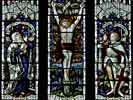 Christ flanked by Christ flanked by Mary and St George |
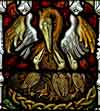 Pelican in piety Pelican in piety |
The Great East Window was the parishioners' war memorial gift 'in memory of the sons of West Bridgford who gave their lives unto the death in the Great War'. It was designed and executed by Herbert W Bryans, Esq, London and dedicated on Sunday, 30th November 1919, when it was unveiled by Mrs Heymann.
A contemporary leaflet described the window:
'This large window which contains Seven Lights as well as a considerable amount of Tracery, has been treated in the following manner. In the Centre Light which dominates the whole Window is a Figure of our Lord upon the Cross, which is lifted up on a green mound behind which is seen a vision of the Holy City. On either side are shewn Saint Mary, the blessed Mother - the Mater dolorosa, and our Patron, Saint George, who is turning towards the Saviour with his right hand uplifted in adoration, whilst in his left he holds a shield bearing the Red Cross. On the right and left in pairs are shewn the Four Fathers of the Church. On the extreme left is Saint Jerome, who is robed in red, as a Cardinal, for though during his life he refused all Ecclesiastical rank it has always been thought fit, for the sake of his dignity, to shew him as a Cardinal. He is reading a book and at his feet is a model of 'The Church,' with rays of light emanating from its portal. Saint Ambrose, Bishop of Milan, is next and he is robed as a Bishop with Mitre, Cope and Dalmatic, holding a Crosier and also his Triple Scourge, an attribute given to him to set forth the ardour with which he punished heresy and sin. On the right side in the Sixth Light, we have Saint Augustine, Bishop of Hippo, in Africa, who was converted to Christianity by the preaching of Ambrose and was baptized in Milan Cathedral in the presence of Monica his mother, on which occasion our 'Te Deum' was composed and sung. He also is robed as a Bishop and is shewn reading the Scriptures. His Cope is fastened with a Red Morse in the shape of a Burning Heart, which expresses the warmth of his piety and also his repentance. In the extreme right we have Saint Gregory, the first Pope who styled himself Servant of the Servants of God. He is shewn with the Papal Tiara wearing a Chasuble and holding a Triple Cross; his hand is uplifted in blessing whilst on his shoulder rests his peculiar attribute, the Dove. Below these figures of the Four Fathers, or Latin Doctors, are shewn the four Evangelists seated, with words in Latin, taken from the opening sentences of their writings, on scrolls above them In the centre three bases we have the Pelican in Piety, feeding its young from the blood of its breast, a symbol of Christ upon the Cross, and on either side is an Angel adoring, with words on scrolls above 'Jesus Christus Noster Pelicanus.'
'The Tracery, which is intricate and forms a very important part of this window, has been most carefully treated. At the very top is an Angel holding a Shield bearing the Holy Name, and below this in the centre of the tracery is shewn the Lamb, the 'Agnus Dei,' surrounded with rays and standing on a green mound from which emanate the four rivers of Paradise. On either side of this opening is an Angel adoring and swinging a censer. In other smaller pieces of tracery we have the symbols of the four Evangelists, namely:- the Man or Angel, the Lion, the Ox, and the Eagle; and over and above these are numerous pieces of tracery still smaller which are treated in an ornamental manner.'
10.Howe Memorial Window
 |
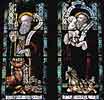 Detail Detail |
This window was a gift from Ernest Harry Howe, a former churchwarden, in memory of his father, Thomas, who had died on 3rd July 1907. At the time, Ernest Howe was a commercial traveller in goods for the decorating trade; he later became managing director of Messrs W Robinson (Nottingham) Ltd, a decorators' merchants.
The window, by Messrs George F Gascoyne & Son, Nottingham, depicts Saint Giles and Simeon and carries the dedication:
To the Glory of God |
According to legend, St Giles was a hermit who lived in a forest with a deer as his sole companion. One day a hunter spied the deer and shot an arrow at her, but the arrow wounded the saint instead, as he tried to protect her. However, this window shows the arrow piercing the deer. Around St Giles are the words 'all ye saints of the Lord bless ye the Lord', which are a variation on Psalm 134:1.
Simeon is shown holding the infant Jesus. Around him are the words from the Nunc Dimittis 'mine eyes have seen thy salvation', Luke 2:30.
South Chapel
11.Triangular Window
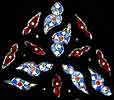 |
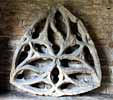 Original window Original windowtracery |
The stained glass forms a mosaic pattern.
This triangular window in the gable above the two east windows is typically 'curvilinear', but the tracery, like that in the northernmost of the pair below it, is a modern reproduction.
The original tracery of this triangular window, of identical pattern, was removed as unsafe in the restoration of 1871-2, and may now be seen resting on one of the stone benches inside the porch. The tracery was, unusually, cut from a single piece of stone.
Christmas Story Windows
Windows 12-13 were designed by Harry Grylls and tell the Christmas story.
12.St Giles
 |
 St Giles St Giles |
 The Manger The Manger |
At the top of the northernmost window is Saint Anne, the mother of the Virgin Mary with Mary.
The central figure in the three main lights is Saint Giles. In the other lights are four scenes from the Christmas story:
My soul doth magnify the Lord. St Anne and the Virgin Mary
Unto you is born this day a Saviour. Mary, Joseph with baby Jesus in the manger
I bring you tidings of great joy Angels and shepherds
Lord, now lettest thy servant depart in peace. Simeon at the presentation in the Temple
13.St Hugh
 |
 St Hugh St Hugh |
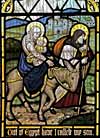 The flight to Egypt The flight to Egypt |
At the top of the southernmost window is the Virgin Mary holding baby Jesus.
The central figure in the three main lights is Saint Hugh of Lincoln, holding Lincoln Cathedral. In the other lights are a further four scenes from the Christmas story:
All Kings shall fall down before him. The visit of the Wise Men
Out of Egypt have I called my son. The flight to Egypt
All that heard him were astonished. The boy Jesus at the Temple
He came to Nazareth and was subject unto them. Jesus as carpenter
14.Sarah Jane Simons Memorial Window
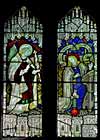 |
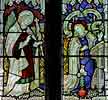 Gabriel and Mary Gabriel and Mary |
This window was the gift of William Henry Simons, a local builder, and his children in memory of William’s wife, Sarah Jane (Abbott) as stated in the dedication:
Giving thanks to God |
The window depicts the Annunciation. In the left light, Gabriel’s rod bears the words 'Ave Maria' while, in the right light, the words 'Ecce ancilla Domini' (Behold the handmaiden of the Lord) appear over Mary.
South Aisle
15.Hemsley Memorial Window
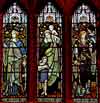 This was the first stained glass window installed in the restored church. The dedication at the foot of the glass reads
This was the first stained glass window installed in the restored church. The dedication at the foot of the glass reads
TO THE GLORY OF GOD AND IN MEMORY OF ELIZABETH HEMSLEY. ERECTED BY HER THREE SONS. AD 1901. |
Elizabeth was a West Bridgford resident as was her eldest son, Charles, who was a manager in the lace trade. The other two sons, Samuel Arthur in London and William Sydney in Nottingham, were both lace manufacturers
The window was by Heaton, Butler & Bayne. The window was described in the parish magazine as having 'beautiful tone and atmosphere'. In three lights, it portrays Faith, Hope and Charity.
16.Transfiguration Window
 |
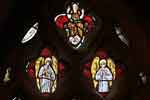 Detail of the tracery Detail of the tracery containing medieval glass |
This window depicts the Transfiguration, Christ is in the centre light, with Moses (carrying the tablets with the ten commandments) on the left and Elijah on the right. Underneath are the words 'Blessed are the pure in heart for they shall see God'.
The window is by Taylor and Clifton and is reputed to contain fragments of medieval glass in the tracery.
17.Jesus and Disciples Window
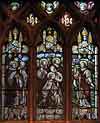 The window depicts the scene where Jesus appears to the eleven and sends them out with the words, at the bottom of the window, 'Go ye into all the world and preach the Gospel to every creature' Mark 16:15. Five disciples are shown in the first two lights, with Christ in the third.
The window depicts the scene where Jesus appears to the eleven and sends them out with the words, at the bottom of the window, 'Go ye into all the world and preach the Gospel to every creature' Mark 16:15. Five disciples are shown in the first two lights, with Christ in the third.
The window is by Taylor and Clifton.
Henry and Clara Ogle Memorial Windows
Windows 18-19 were designed by Harry Grylls.
18.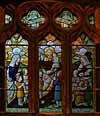 'Suffer little children to come unto me'
'Suffer little children to come unto me'
The window on the south wall has the words 'Suffer little children to come unto me' (Luke 18:16). The main lights depict Christ in the centre, surrounded by children, with two mothers who have brought their children to Him. At the foot of the window is the dedication:
| To the glory of God and in memory of Henry and Clara Ogle. This and the adjoining window were given by their daughter. |
The windows were dedicated at a special service of Freemasons on Sunday, 29th April 1934; Henry Ogle had been a member of the Southwell Lodge of Freemasons and had died on 27th March 1917. He was a tailor, owner of Porter & Co at 47 Clumber Street, Nottingham. His wife Clara (née Billyeald) had died on 14th April 1932. Their daughter May (known as Maisie) married Ernest Cyril Roe in 1918.
Inner South Aisle
Clerestory Windows
The six clerestory windows in the old nave each have two lights and show the twelve apostles.
The windows were given by the aid of friends of the family of the rector of the time, Henry Marsh Marsh-Edwards. He also had plans for a window over the side altar showing the Transfiguration and for St Giles in the side window and west window in what was the men’s vestry. He also declared that the Sunday School children and staff had undertaken to have a window showing Christ blessing little children in the baptistry. The clerestory windows were installed in 1903. Marsh-Edwards left the parish soon afterwards but those ideas for other stained glass were eventually realised.


